
 |
 |
Science
Olympiad
| Phylum Arthropoda | |
| Arthropods
are the most successful and diverse of all animal phyla.
Of the known million species of animals, approximately
900,000 are arthropods. One order of insects, Coleoptera
(beetles)
has as many species as the entire plant kingdom (Arnett
& Jacques, 1981, p. 16). A few acres of tropical
forest can contain over a billion arthropods.
Ant colonies may house over one million individuals.
A cubic meter of ocean water may be home to millions
of arthropods
(Prothero, 1998, p. 248). Arthropods are very versatile
and have evolved adaptations that allow them to live
in all habitats from the deepest oceans to the highest
mountains,
from
the coldest ice
to the hottest deserts. In the history of life on Earth
arthropods lay claim to many evolutionary
firsts. Arthropod Firsts Traditionally,
it was argued that arthropods share a common ancestor with
annelid worms. Annelids and
Arthropods have a coelom and a segmented body. However, molecular
phylogentics analyses comparing DNA and RNA indicate that
arthropods are more closely related to the roundworms or
nematodes (Prothero, 2007, p. 193). Arthropods were the
first animals
to have
jointed appendages. Joints
permit powerful movement, aid in locomotion and can be modified
to serve many functions. The name arthropod means jointed
foot. Trilobites were the first animals with eyes that were
capable of forming images (Johnson & Raven, 2001).
Arthropods were the first animals to invade land during
the Silurian
period
(millipedes,
followed
by
scorpions,
spiders,
and eventually insects) (Prothero, 1998, p. 248). Arthropods
were the first organisms to evolve wings. Insects took to
the skyies 100 million years before the flying reptiles of
the Mesozoic. Arthropods success and diversity is due to mainly two factors. First, arthropod jointed appendages are susceptible to adaptive specialization. Legs, mouthparts antennae, claws pincers, swimming paddles, and gills represent some of the specializations. Second, their exoskeleton provides protection and mechanical advantage. The exoskeleton serves as an external armor for protection against the environment and predators. Leverage is increased in arthropods as the muscles pull from the inside of the exoskeleton instead of muscles pulling from the outside of an internal skeleton as in vertebrates. The exoskeleton is not a living tissue and does not grow. Therefore, the exoskeleton must be shed or molted in order for growth to occur. After molting an arthropod can make radical body changes in its body plan before the new skeleton dries and hardens, allowing for the evolution of life cycles that include metamorphic processes. Having your skeleton on the outside can also make you vulnerable at times as well as place limits on size. After molting the soft exposed body is vulnerable to predators. Arthropods must hide from predators during molting. In molting its exoskeleton the arthropod has lost most of its structural support. If the body were too large it would lose its integrity after the first molt "dissolving" into a blob. The size to which an animal with an external skeleton can evolve also depends on the buoyancy provided by its surroundings. The largest arthropods to evolve did so in the marine environment. On land oxygen levels may also limit arthropod size as respiration through book lungs and tracheae depend partly on diffusion. The exoskeleton is made of chitin (polysaccharide and protein). In some groups, such as trilobites and ostracodes, the cutile is also mineralized with calcite. Arthropods with chitin reinforced with calcite leave a good fossil record. Unfortunately, most arthropods have exoskeletons made only of chitin, which explains why overall the arthropod fossil record is poor. Luckily, fossil lagerstatten that preserve nonmineralized tissues, such as Baltic amber, the Burgess Shale, and the Florissant fossil beds provide important windows into arthropod evolution. Arthropods can be divided into four subphylums. The subphylum Tracheata or Uniramia (millipedes, centipedes, and insects) inlude arthropods with jaws. Arthropods with fangs or pincers belong to the subphylums Trilobitomorpha (trilobites), Crustacea (lobsters, crabs, shrimps, crayfish, barnacles, ostracodes, and pill bugs) and Chelicerata (scorpions, mites, spiders, horseshoe crabs, and eurypterids). Trilobitomorpha Trilobites range from the Cambrian to the Permian. Next to ostracodes they are the most common arthropod fossil. Trilobite means three-lobed and refers to the three longitudinal divisions of their calcified exoskeleton. An axial lobe running down the center is attached to pleural lobes on either side. The head or chephalon is separated from the tail or pygidium by thorasic segments. As juveniles, trilobites were pelagic, swimming in the plankton. As adults, most trilobites were benthic detritus feeders, although there are some exceptions such as the agnostids, which are thought to have lived a pelagic life due to their world-wide distribution. Trilobites were one of the first organisms to have eyes and may have been the first with eyes that focused images. Many trilobite species lost their eyes through selection such as the agnositds and Cryptolithus. Trilobites have compound eyes made of calcite crystals. Two important types of compound eye can be found in trilobites. Holochroal eyes consisted of hundreds (up to 15,000) of closely packed elongated prisms of calcite arranged in a hexagonal pattern (Fortey, 2000, p. 99). The lenses of these eyes must be viewed with the aid of magnification. Holochroal eyes produced composite images of the world, but with little resolution. Phacops trilobites possessed schizochroal eyes. Schizochroal eyes are made of larger spherical-shaped lenses numbering in the hundreds (up to 700) and separated by exoskeleton. Each lens is made of two calcite crystals arranged as a doublet lens. Ironically, the doublet lens was designed by Dutch scientist Christian Huygens (1629-1695) and the French philosopher Rene Descartes (1586-1650) to correct for spherical aberration. Through selection nature had anticipated the same design 400 million years earlier. The phacopid lens produced larger images bringing them into sharp focus (Fortey, p. 106). Trilobites enjoyed a great adaptive radiation during the Cambrian reaching their peak in abundance and diversity. In fact, Trilobites are the biostratigraphic standard for the Cambrian. Trilobites declined during the Ordovician and were only a minor part of the seafloor fauna in the Silurian and Devonian. Trilobites did enjoy some increase in diversity during the Devonian; however, they never fully recovered from the late Devonian extinction event and vanished during the Permian. Phacops rana is the state fossil for Pennsylvania. Isotelus is the state fossil for Ohio. Calymene celebra is the state fossil for Wisconsin. Chelicerata Chelicerates include spiders, scorpions, mites, ticks, horseshoe crabs, and eurypterids. The chelicerate body is divided into a cephalothorax and the abdomen. They do not have antennae. The mouth parts are composed of chelicerae(small claws or fangs) and pedipalps. Pedipalps are modified into pincers in scorpions, eurypterids, and some spiders. The thorax has 4 pairs of legs. The subclass Arachnida includes spiders, scorpions, ticks, and mites. Trigonotarbids are spider-like arachnids that lack poison glands and silk-producing organs, but they do have book lungs. Trigonotarbids make their first appearance in the Silurian. The first true spider, pseudoscorpions, scorpions, and mites make their first appearance during the Devonian. Eurypterids are an extinct group of arthropods in the subclass Eurypterida. The eurypterid is a chelicerate arthropod and looks like a cross between a scorpion and lobster. Eurypterids range from the Ordovician to the Permian. Eurypterids were major marine predators during the Silurian. The Eurypterid Eurypterus remipes is the state fossil for New York. Horseshoe crabs belong to the subclass Xiphosura. Primitive horseshoe crabs make their first appearance in the Silurian. In the early Paleozoic horseshoe crabs evolved into a variety of body forms. Horseshoe crabs similar to the present day Limulus do not appear until the Pennsylvanian. Crustacea Crustaceans range from the Cambrian to recent times. Today, crustaceans are the most successful arthropods in marine environments. Crustaceans also inhabit freshwater environments and a few are terrestrial. Familiar crustaceans include shrimp, lobsters, crabs, crayfish, barnacles, water fleas (Daphnia), and pill bugs. The body and legs of crustaceans are enclosed in a chitinous shell, which in some species is reinforced with calcium containing minerals. Crustaceans have two pairs of sensory antennae, three pairs of limbs used to handle and push food into the mouth, and biramous walking legs that may have gills. The general body plan of crustaceans consists of a head, thorax, and abdomen. The head and throax are often fused into a cephalothorax and the abdomen often ends in a tail-like structure. All crustaceans develop from a distinctive larva type known as nauplius. Many taxa below the class level leave no fossil record; however, two classes, Malacostraca and Maxillopoda have a substantial fossil record. The class Malacostraca includes crabs, shrimps, lobsters, krill, pillbugs, and amphipods. Some of the earliest crustaceans from this class included shrimp-like organisms called phyllocarids, which first appear in the Cambrian. The familiar order of Decapods (crabs, lobsters, crayfish and shrimps) did not appear until the Devonian period. The Decapods underwent a great adaptive radiation during the Mesozoic. Crabs make their first undisputed appearance in the Jurassic. Predation during the Mesozoic from crabs and lobsters may have forced mollusks to burrow and many brachiopods to go extinct (Protheros, 1998, p. 265). The class Maxillopoda includes ostracodes, copepods, barnacles, and many shrimp-like forms. Barnacles and ostracodes have calcified skeletons that fossilize well. Barnacles (subclass Cirripedia) are strictly marine organisms and range from Ordovician to recent times. The barnacle nauplius larva changes into a shrimp-like, bivalved organism. The shrimp-like organism adheres its head to a surface, casting off its bivalved shell. After a profound metamorphosis the adult form becomes cemented to the substrate and the mantle, which encloses its body, secretes a calcareous shell. The calcareous shell is made of side plates and lid plates. The lid plates are needed for precise identification, but are rarely fossilized. Most barnacles attach to hard surfaces and are filter feeders. Some species burrow into the shells of mollusks and corals. Still others are parasitic and burrow into other organisms. Ostracodes (subclass Ostracoda) are the most common fossil arthropods and range from early Cambrian to recent times. Ostracodes are usually microscopic crustaceans with a pair of kidney-bean-shaped calcareous shells hinged over their back. Ostracodes are rapidly evolving, abundant microfossils, making them very useful for biostratigraphy. Ostracodes are sensitive to depth and water conditions, which makes them useful tools for studies in paleoecology. Tracheata or Uniramia Tracheates include millipedes, centipedes, and insects. Millipedes and centipedes belong to the class Myriapoda. Millipedes have two pairs of legs per segment. Millipedes have a long tubular body covered with a calcified cuticle coated with wax and equipped with up to 200 pairs of legs. Millipedes live among rotting vegetation and are mostly scavengers or detritus feeders. Possible millipede trace fossils are found in the Ordovician, which would make them the first animals to invade land. Millipede body fossils first appear in the Silurian. Centipedes have a more flattened body with fewer segments and only one pair of legs per body segment. Centipedes have at most a few dozen pairs of legs. Centipedes are carnivores equipped with poison claws and fangs. Centipedes first appear in the Silurian. Insects are the most successful animal in terms of numbers and diversity. Insects belong to the epiclass Hexapoda and the class Insecta. Hexapoda consists of entognathous hexipods and the true insects. Entognathus hexipods have their mouthparts recessed within their head, springtails are a familiar example. The insect body plan consists of a head with antennae, thorax with six legs, and an abdomen. The insect cuticle does not fossilize well. At the species level the insect fossil record is poor; however, at higher taxonomic levels the resolution improves. At the family level 63% of living families are represented in the fossil record. At the order level 100% are represented. Primitive wingless insects first appear in the Devonian. Insects with wings (Pterygota) make their first appearance in the Pennsylvanian. There is evidence to suggest that insects with fixed wings (Paleoptera), like mayflies, came before those with folded wings (Neoptera), like cockroaches. Herbivorous insects make their first appearance in the Carboniferous. Insects up through the Carboniferous undergo incomplete metamorphosis (superorder Exopterygota or Hemipterodea). Insects with complete metamorphosis (superorder Endopterygota or Holometabola) make their first appearance in the Permian. Social insects make their first appearance in the Cretaceous. Fleas, which are parasites to mammals, do not appear in the fossil record until the Cretaceous. Insect Trace Fossils Insect ichnofossils (trace fossils) can be helpful in determining what types of insects were present at a particular time and provide information about the nature and persistence of past plant-insect associations. Evidence for herbivory in insects appears in the Carboniferous. Like vertebrates, the first insects were carnivores and detritivores. Herbivory requires hosting cellulose-digesting bacteria through a symbiotic relationship within the gut. The oldest examples of marginal and surface feeding are on Carboniferous seed fern leaves of Neuropteris and Glosspteris (Grimaldi & Engel, 2005, p. 52). It is estimated that only 4% of the leaves in Carboniferous deposits exhibit damage from feeding. Herbivores do not make a significant impact on plant life until the Permian (Kenrick & Davis, 2004, pp. 166-167). Galls are excessive growths on stems, leaves, cones, and flowers caused by insect feeding or egg laying. The earliest fossil galls are found on the petioles of Psaronius tree ferns of the Late Carboniferous. Insect gall fossil diversity and abundance takes off with the advent of flowering plant evolution in the Cretaceous (Grimaldi & Engel, 2005, p. 53). Insects produce tunnels in wood known as borings or galleries. Some insects eat the cambial layer while others eat fungus that grows within the galleries, still others eat the wood itself. The oldest borings and galleries in wood, attributed to mites, are known from the Carboniferous. The first definitive beetle borings are from the Triassic. There are some borings in permineralized Triassic-aged wood from Arizona that are attributed to termites or bees; however, they may be beetle borings (Grimaldi & Engel, 2005, p. 54 & 55). Leaf mines are meandering tunnels produced by the feeding larvae of some beetle, fly, and sawfly species. The first definitive leaf mines first appear in the leaves of Triassic conifers and pteridosperms. Interestingly, the abundance and diversity of fossil leaf mines coincides with the radiation of flowering plants (Angiosperms) during the Cretaceous. Leaf mines have been used to establish the peristence of insect and plant associations. For example, the larvae of certain moth families have been eating the leaves of Quercus (oak) and Populus (poplars) for 20 million years and hispine beetles have been eating the leaves of Heliconia for 70 million years (Grimaldi & Engel, 2005, p. 52). Caddisfly larvae live in lakes, ponds, and rivers. Many build distinctive protective cases from bits of sand, shells and vegetation. Fossil caddisfly cases can often be identified to the family or even genus level. The oldest larval caddisfly cases (Trichoptera) are found in the Jurassic (Grimaldi & Engel, 2005, p. 51). Celliforma is
a fossil bee nest (in the form of subterranean excavations)
that is first found in Late Cretaceous deposits. Celliforma is
found from the Cretaceous to the Pliocene (Grimaldi & Engel,
2005, p. 51). Termite borings appear in the Cretaceous
and represent the oldest undisputed fossil nest for social
insects (Grimaldi & Engel, 2005, p. 54). Coprinisphaera is
the fossil burrow of a scarabaerine dung beetle, which
makes its first apperance during the Paleocene. Coprinisphaera lived
from the Paleocene to the Pleistocene and had a wide geographic
range being found in South America, Antarctica, Africa
and Asia. Coprinisphaera coincide with the evolution
of the first ecosystems to have abundant mammalian herbivores. Evidence
for the first scarab tunnels are found in the coprolites
of herbivorous
dinosaurs from the Late Cretaceous of Montana (Grimaldi & Engel,
2005, p. 50). | |
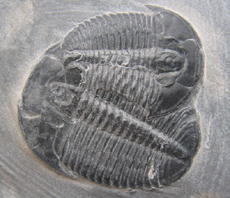 Elrathia kingii House Range and Drum Mountains Western Utah, USA Wheeler Shale Formation Cambrian: 505 Million Years |
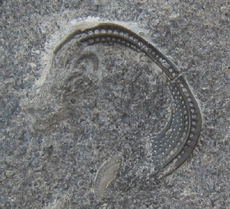 Trilobite Molt Cryptolithus tessellatus Kope Formation Ordovician Ft. Mitchell, KY |
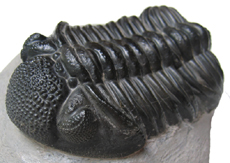 Trilobite Phacops megalomanicus Devonian Atlas Mountains, Morocco 9.5 cm long x 5.5 cm wide |
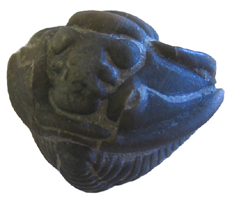 Trilobite Flexicalymene meeki Arnheim Formation Ordovician Mt. Orab, OH |
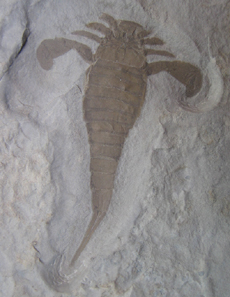 Eurypterus remipes Fiddler Green Formation Phelps Member Upper Silurian Herkimer Co., New York Specimen is 9 cm long |
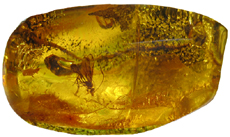 Baltic Amber with Inclusion Wasp (Order Hymenoptera) Cenozoic; Paleocene; Eocene Yantarny, Kaliningrad, Russia 4.5 cm long x 3 cm wide x 1.5 cm thick |
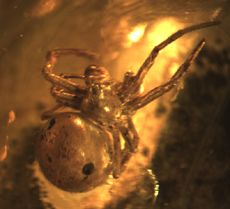 Spider Cenozoic; Paleocene; Eocene Primorskoje, Kaliningrad, Russia
|
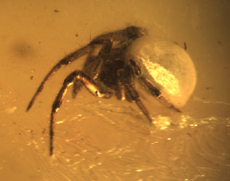 Spider Cenozoic; Paleocene; Eocene Primorskoje, Kaliningrad, Russia |
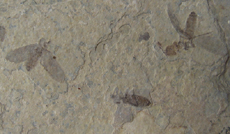 Carbonized Insects Green River Formation Cenozoic; Paleocene; Eocene Kemmerer, Wyoming Slab 6 cm x 4 cm
|
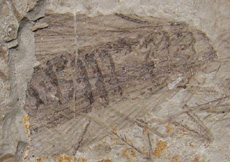 Carbonized Insect Yixian Formation Cretaceous Lioaning Province, China |
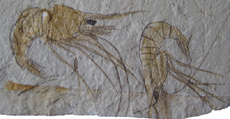 Shrimp Cretaceous Haquel, Lebanon |
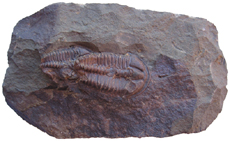 Trilobite Conocoryphe sulzeri Middle Cambrian Jince, Czech Republic Larger Tilobite 3 cm |
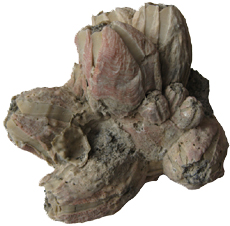 Barnacles Balanus concavus Miocene Tamiami Formation Port Charlotte, Florida 10 cm tall x 10 cm wide |
|
Bibliography |
|
| Arnett,
R.H. Jr. & Jacques, R.L. Jr. (1981). Simon & Schuster's
Guide to Insects. New York: Simon & Schuster, Inc.
Fortey, R. (2000). Trilobite: Eyewitness to Evolution. New York: Vintage Books. Grimaldi, D. & Engel, M.S., (2005). Evolution of the Insects. New York: Cambridge University Press. Johnson, G.B. & Raven, P.H. (2001). Biology: Principles & Explorations. New York: Holt, Rinehart & Winston. Nudds, J.R. & Selden P.A. (2008). Fossil Ecosystems of North America: A Guide to the Sites and Their Extraordinary Biotas. Chicago: University of Chicago Press. Prothero, D.R. (1998). Bringing Fossils to Life: An Introduction to Paleobiology. New York: McGraw-Hill. Prothero, D.R. (2007). Evolution: What Fossils Say and Why It Matters. New York: Columbia University Press. Selden P. & Nudds, J. (2004). Evolution of Fossil Ecosystems. Chicago: The University of Chicago Press. |
|










